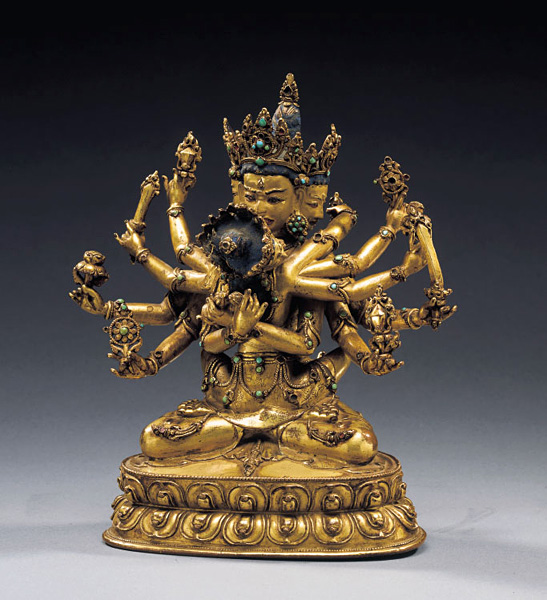|

The Guhyasamaja-tantra is one of the oldest and most basic texts of Vajrayana Buddhism. Guhyasamaja is one of the first and most important gods of the Tantric-Buddhist pantheon; an emanation of the cosmic Buddha Aksobhya, the embodiment of consciousness, in his Yi-Dam form (as Buddhist protector). Guhyasamaja's manifestation was in particular favoured by the Geluk-order; his name implies a secret union or assembly of the secret ones. This lord of the diamond body, speech, and mind comprising all the cosmic Buddhas, holds his prajna (female consort) in sexual embrace (yab-yum). The goddess is supposed to project an energy and ferocity that contrasts and is complementary with the serene countenance of her male partner.
Guhyasamaja is seated in vajrasana (his legs crossed) on a double lotusthrone and is depicted with three heads and six arms. His prajna has an identical number of heads and arms; she is portrayed in sexual embrace around her partner, two of her most raised hands around his neck and with her legs around his hip. On their heads they wear crowns, the central leaf bearing a wheel of law, and their hair being tied up into a high chignon, topped by a cintamani (flaming pearl). The sign of illumination (the urna) is depicted on all six heads. The male god has flowers sticking out just above his ears. Both deity's are adorned with earrings, necklaces, bracelets, anklets, skirts, shawls, girdles of pearls and ornaments. Although the two gods are complementary they both have an identical number of arms, legs and heads as well as similar attributes. Guhyasamaja's hands are crossed in front of his chest holding a vajra (thunderbolt) and a ghanta (bell with vajra handle). His right hands hold a padma (lotusflower and symbol of purity and spiritual elevation) and a cakra (the wheel of the Buddhist law). His left hands hold a khadga (sword protecting wisdom) and a cintamani (a flaming pearl). The original gilded seal is beautifully engraved with a vishvavajra, symbol of the four cardinal points of the universe.
Being of a Tibetan origin, the bronze clearly exemplifies the high quality of technical skills and lively artistic imagination of the newari masters during the Malla kingdom period in Nepal. The style of the crowns, the fine turquoise inlay, the engraved design on the dresses, the jewellery and ornaments as well as the fine gilding, the fine copper alloy and the perfection of anatomy are all typical characteristics of dated and datable pieces of the 15th century. The well executed back includes pronounced and finished lotusleaves. The use of polychrome on the faces, the tantric iconography, and the seal are typical elements of a bronze originating from a Tibetan monastery.
The inspired composition of this tantric Buddhist protection couple has a majestic presence. The various positions and movements of in particular the twelve arms lend the piece a sense of dynamic rhythm and energy, revealing the couple's physical and emotional inseparability. Most striking is the precision of casting and stone inlay, with finely articulated details, perfect anatomy and the well balanced positions of heads, bodies and arms. This rare icon of Guhyasamaja is mesmerising from all angles and one of the best examples of its kind, a superb and classical example of Tibetan tantric art.
Exhibited: Tantra, Hayward Gallery, Arts council of Great Britain, London, 1971.
Published: Philip Rawson, Tantra, Hayward gallery, London, 1971, no. 114, page 37.
Published: Philip Rawson, Sacred Tibet, Singapore, 1991, page 95.
Provenance: Collection Philip Goldman, London.
|

